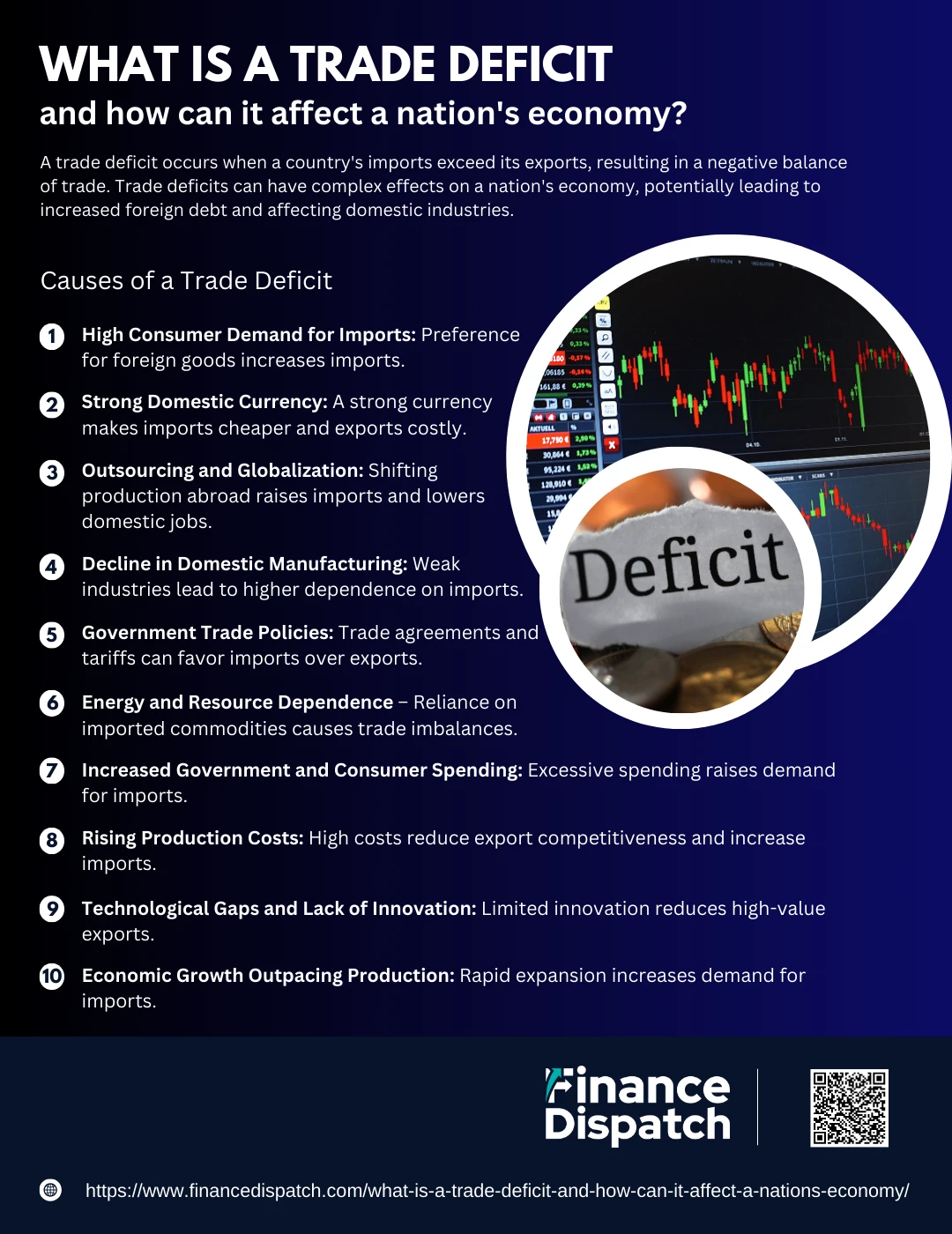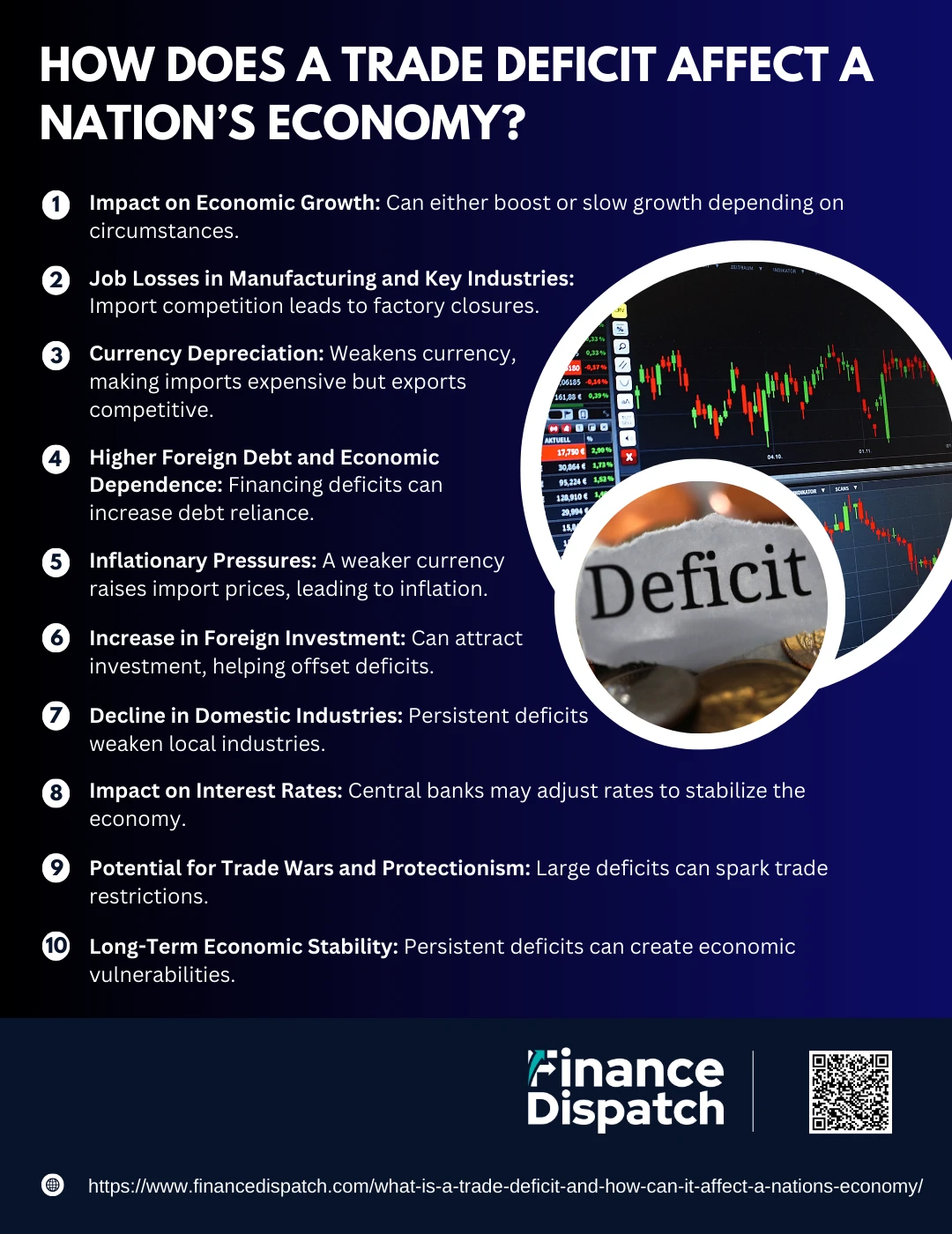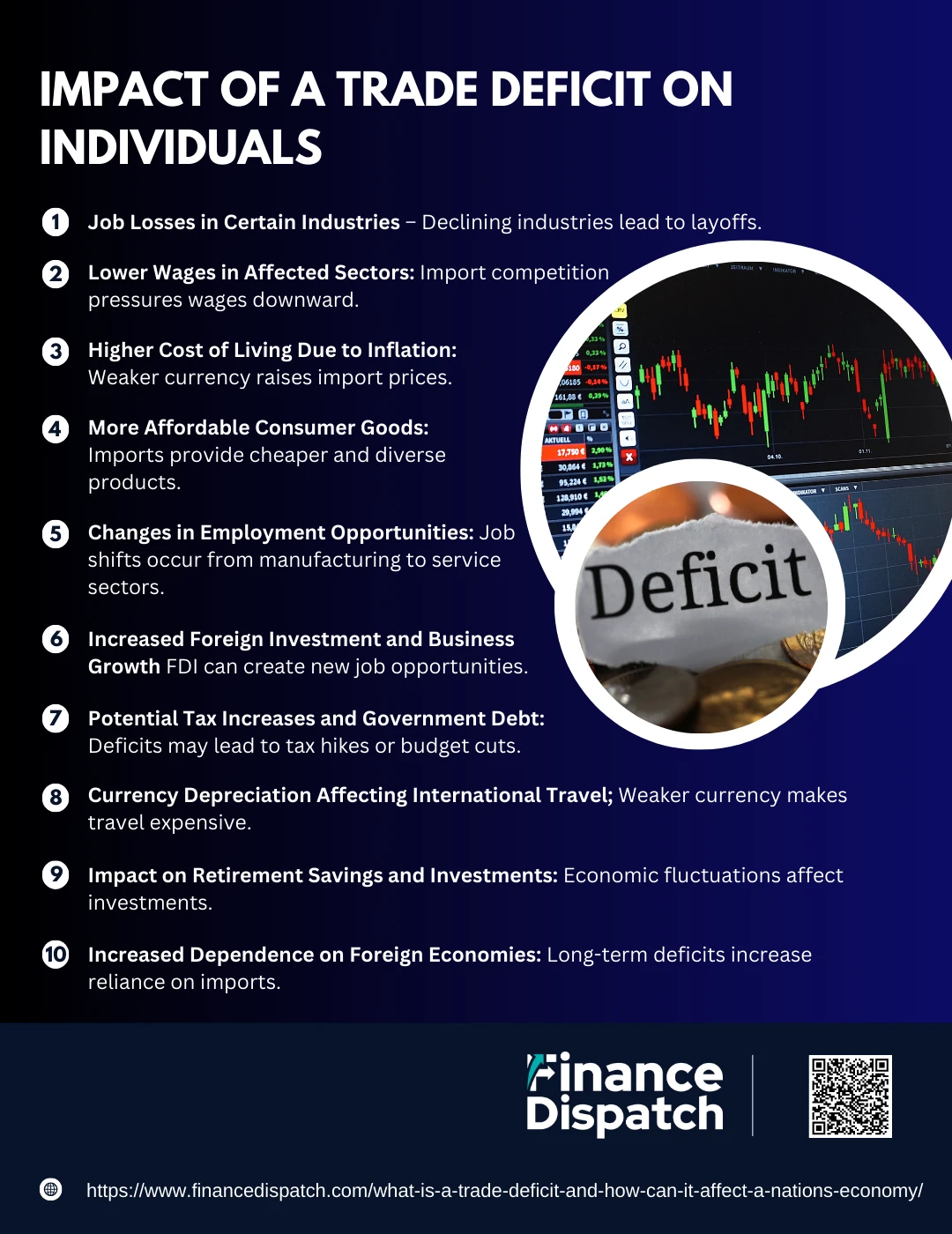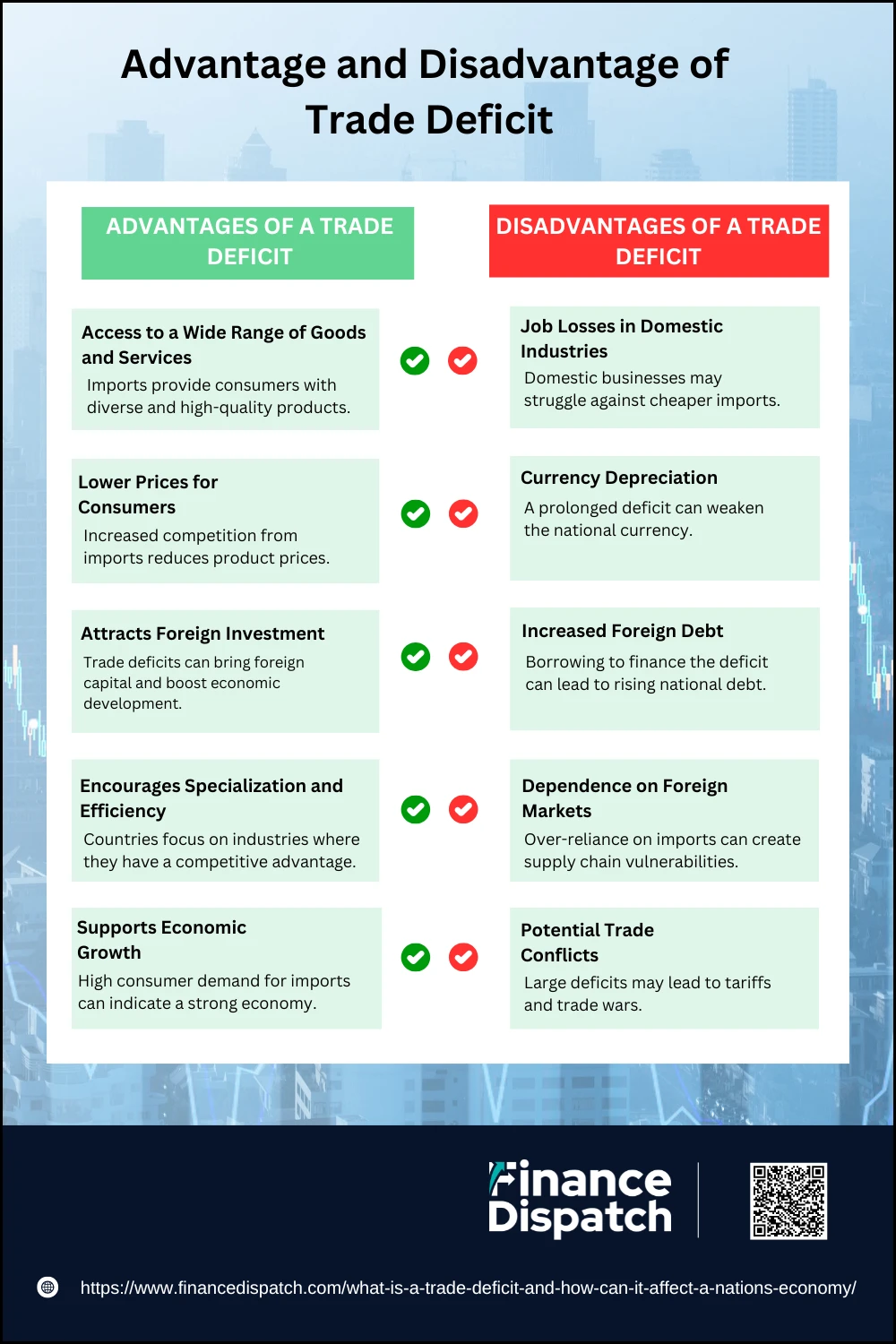A trade deficit occurs when a country imports more goods and services than it exports, resulting in a negative balance of trade. While the term “deficit” often carries negative connotations, the impact of a trade deficit on a nation’s economy is more complex than it may seem. Some view it as a sign of economic weakness, suggesting that it leads to job losses and financial instability. Others argue that trade deficits can drive economic growth by increasing consumer choice, fostering foreign investment, and promoting global trade relationships. Understanding the causes and consequences of a trade deficit is crucial in evaluating its true effect on a nation’s economic health. This article explores what a trade deficit is, its advantages and disadvantages, and how it influences key economic factors such as employment, currency value, and trade policies.
What is a Trade Deficit?
A trade deficit occurs when a country’s total value of imports exceeds the total value of its exports over a specific period. In simple terms, it means a nation is buying more goods and services from other countries than it is selling to them. This imbalance can arise due to various factors, such as consumer demand for foreign products, differences in production costs, currency valuation, or government trade policies. While trade deficits are often viewed negatively, they are not inherently bad. They allow countries to access a diverse range of goods, attract foreign investments, and support domestic industries reliant on imported materials. However, a prolonged trade deficit can also pose economic risks, such as increased foreign debt, loss of domestic jobs in key industries, and currency depreciation. Understanding the complexities of trade deficits is essential to assessing their broader economic impact.
 Causes of a Trade Deficit
Causes of a Trade Deficit
A trade deficit occurs when a country imports more goods and services than it exports, leading to an imbalance in trade. While it can be a sign of strong consumer demand and economic growth, a persistent trade deficit may also indicate deeper structural issues within the economy. Various factors contribute to trade deficits, ranging from macroeconomic policies to shifts in global trade patterns. Some causes are linked to consumer preferences and government decisions, while others arise from competitive disadvantages in domestic industries. Below are the key reasons why a country may experience a trade deficit:
1. High Consumer Demand for Imports
When consumers prefer foreign goods over domestically produced alternatives, imports rise. This is especially common in countries with a strong currency, where foreign products appear cheaper, or in nations where domestic industries cannot meet consumer demand in terms of quality, variety, or pricing.
2. Strong Domestic Currency
A strong currency makes imported goods more affordable for local consumers but simultaneously makes exports more expensive for foreign buyers. This results in an increased demand for imports while reducing global demand for domestic products, widening the trade deficit.
3. Outsourcing and Globalization
Many companies relocate production to countries with lower labor costs to increase profitability. While this reduces production costs for businesses, it leads to higher imports of finished goods and a decline in local manufacturing jobs, contributing to the trade deficit.
4. Decline in Domestic Manufacturing
When industries struggle to compete with foreign producers due to high labor costs, outdated technology, or inefficient production methods, domestic output declines. As a result, countries become more dependent on foreign goods, leading to an increase in imports.
5. Government Trade Policies
Trade agreements, tariffs, and regulatory frameworks significantly impact trade balances. If a government enacts policies that favor imports—such as low import tariffs or free trade agreements without sufficient export incentives—imports can outpace exports, resulting in a trade deficit.
6. Energy and Resource Dependence
Countries that rely on imports for essential commodities like oil, gas, and raw materials often run trade deficits. These essential imports are difficult to replace with domestic alternatives, leading to a structural trade imbalance that persists over time.
7. Increased Government and Consumer Spending
When government spending rises, especially on imported goods or services, it contributes to trade imbalances. Similarly, consumer spending that exceeds domestic production capacity leads to higher demand for foreign products, further expanding the deficit.
8. Rising Production Costs
Higher wages, taxes, and raw material costs can make domestically produced goods more expensive than their foreign counterparts. This weakens the competitiveness of domestic industries, reducing exports while increasing reliance on imports.
9. Technological Gaps and Lack of Innovation
If a country lags behind in innovation, research, and technological advancements, it may struggle to develop high-value exports. Economies that fail to keep up with global trends in automation, artificial intelligence, or manufacturing efficiency often see their export competitiveness decline, leading to a growing trade deficit.
10. Economic Growth Outpacing Production
Rapid economic expansion can lead to increased consumer and business demand for goods and services that cannot be met domestically. As a result, imports rise faster than exports, contributing to a trade imbalance.
 How Does a Trade Deficit Affect a Nation’s Economy?
How Does a Trade Deficit Affect a Nation’s Economy?
A trade deficit can have a wide range of effects on a nation’s economy, influencing everything from employment and industry growth to currency value and inflation. While some economists argue that trade deficits enable access to a broader range of goods and attract foreign investments, others caution that persistent deficits can lead to job losses, economic dependence, and a weaker domestic currency. The impact of a trade deficit depends on the overall economic environment, government policies, and the ability of domestic industries to remain competitive. Below are the key ways a trade deficit can affect a country’s economy:
1. Impact on Economic Growth
A trade deficit can either stimulate or slow economic growth, depending on how the country manages it. If imports contribute to consumer satisfaction and business efficiency, growth may continue. However, if the deficit signals weak domestic production, it may hinder long-term economic expansion.
2. Job Losses in Manufacturing and Key Industries
When a country imports more goods than it produces, domestic industries may struggle to compete with cheaper foreign alternatives. This can lead to factory closures and job losses, particularly in manufacturing and labor-intensive sectors.
3. Currency Depreciation
A prolonged trade deficit can weaken a country’s currency as more money flows out to pay for imports than comes in through exports. A weaker currency may make imports more expensive, leading to inflation, but it can also make exports cheaper and more competitive in global markets.
4. Higher Foreign Debt and Economic Dependence
To finance a trade deficit, a country may need to borrow from foreign lenders or attract foreign investment. While foreign capital can boost economic development, excessive borrowing can lead to rising debt levels, making the country vulnerable to economic downturns.
5. Inflationary Pressures
If a country’s trade deficit leads to a weaker currency, the cost of imports rises, causing inflation. Higher import prices can increase the cost of living and reduce consumers’ purchasing power, particularly in economies heavily reliant on foreign goods.
6. Increase in Foreign Investment
A trade deficit can also attract foreign direct investment (FDI) as foreign companies invest in local businesses and infrastructure. If managed wisely, this investment can boost productivity, create jobs, and offset some of the negative effects of the deficit.
7. Decline in Domestic Industries
Over time, a persistent trade deficit can erode domestic industries that fail to compete with imported products. This can reduce innovation, productivity, and economic self-sufficiency, making the country more dependent on foreign producers.
8. Impact on Interest Rates
To control inflation and manage economic stability, central banks may adjust interest rates in response to trade deficits. Higher interest rates can attract foreign investment but may also slow domestic economic growth by making borrowing more expensive.
9. Potential for Trade Wars and Protectionism
Large trade deficits can lead to political and economic tensions between countries. In an effort to reduce the deficit, governments may impose tariffs or trade restrictions, which can trigger retaliatory actions from trade partners, potentially harming global trade relations.
10. Long-Term Economic Stability
If a trade deficit persists without corresponding economic growth, it can pose long-term risks to economic stability. Excessive reliance on imports and foreign financing may create vulnerabilities that make the economy more susceptible to global market fluctuations.
 Impact of a Trade Deficit on Individuals
Impact of a Trade Deficit on Individuals
A trade deficit not only affects a nation’s economy but also has a direct impact on individuals, influencing job opportunities, wages, purchasing power, and overall financial stability. When a country imports more than it exports, it can lead to changes in the cost of living, employment rates, and government policies that shape everyday life. Some effects may be positive, such as access to a wider variety of goods at competitive prices, while others, like job losses in manufacturing, can create long-term economic challenges. Below are some key ways a trade deficit can impact individuals:
1. Job Losses in Certain Industries
A persistent trade deficit often leads to a decline in domestic industries, particularly in manufacturing and production sectors. As companies struggle to compete with cheaper imports, factories may close, leading to layoffs and fewer job opportunities.
2. Lower Wages in Affected Sectors
In industries facing strong import competition, employers may reduce wages to stay competitive. This can affect workers in manufacturing, textiles, and other production-based sectors where imported goods are cheaper.
3. Higher Cost of Living Due to Inflation
If a trade deficit weakens the national currency, the cost of imported goods rises, leading to inflation. This affects everyday expenses such as food, electronics, and fuel, reducing individuals’ purchasing power.
4. More Affordable Consumer Goods
On the positive side, trade deficits can result in cheaper imports, giving individuals access to a wider range of products at lower prices. This can benefit consumers by increasing affordability and product variety.
5. Changes in Employment Opportunities
As traditional manufacturing jobs decline, new jobs may emerge in industries that benefit from global trade, such as technology, logistics, and retail. However, workers in affected sectors may need to retrain or shift careers.
6. Increased Foreign Investment and Business Growth
Foreign companies investing in domestic markets due to a trade deficit can create new job opportunities. This investment can lead to the expansion of businesses, especially in urban areas, and stimulate economic activity.
7. Potential Tax Increases and Government Debt
Governments may borrow money to cover the financial shortfall caused by a trade deficit. This could lead to higher taxes or cuts in public spending, impacting education, healthcare, and social services.
8. Currency Depreciation Affecting International Travel
A weaker national currency due to a prolonged trade deficit can make international travel more expensive for individuals. Vacations, overseas education, and imports of foreign luxury items may become costlier.
9. Impact on Retirement Savings and Investments
Trade deficits can influence financial markets, affecting stock prices and interest rates. Individuals with retirement funds, stocks, or bonds may see fluctuations in their investment returns due to economic uncertainty.
10. Increased Dependence on Foreign Economies
A long-term trade deficit can make a country reliant on foreign producers for essential goods. This may create supply chain risks, affecting the availability of products and job stability in key industries.
Trade Deficit vs. Trade Surplus: A Comparative View
A trade deficit and a trade surplus represent opposite ends of a country’s trade balance. A trade deficit occurs when a country imports more than it exports, leading to an outflow of domestic currency to foreign markets. This can result in economic challenges such as job losses in local industries, currency depreciation, and increased foreign debt. On the other hand, a trade surplus happens when a country exports more than it imports, bringing in more revenue and strengthening its economy. While a surplus is generally seen as beneficial, it can also lead to economic imbalances, such as excessive reliance on exports or trade tensions with other nations. Below is a comparative view of trade deficits and trade surpluses:
Trade Deficit vs. Trade Surplus: A Comparative Table
| Factor | Trade Deficit (Imports > Exports) | Trade Surplus (Exports > Imports) |
| Definition | Occurs when a country imports more than it exports. | Occurs when a country exports more than it imports. |
| Economic Impact | Can lead to economic instability, increased foreign debt, and currency depreciation. | Generally strengthens the economy, increasing national income and reserves. |
| Effect on Currency | May weaken the domestic currency due to higher demand for foreign exchange. | Strengthens the domestic currency as demand for local goods increases. |
| Job Market Impact | Can lead to job losses in industries unable to compete with imports. | Creates jobs in export-oriented industries and boosts economic activity. |
| Consumer Benefits | Provides access to a variety of foreign goods, often at lower prices. | May lead to limited availability of foreign goods and higher domestic prices. |
| Government Response | Often leads to trade policies such as tariffs, import restrictions, or currency interventions. | May result in government policies to encourage domestic consumption and investment. |
| Investment Flow | Requires foreign investment to balance trade deficits, increasing foreign ownership of assets. | Attracts foreign investors due to economic stability and strong trade performance. |
| Long-Term Risks | Increased reliance on foreign goods and services, potential debt accumulation. | Risk of trade disputes, overreliance on exports, and domestic inflation. |
 Advantage and Disadvantage of Trade Deficit
Advantage and Disadvantage of Trade Deficit
A trade deficit occurs when a country imports more goods and services than it exports, leading to a negative trade balance. While often viewed as a sign of economic weakness, a trade deficit is not inherently bad. In some cases, it allows for economic expansion, access to a broader range of goods, and increased foreign investment. However, a prolonged trade deficit can also pose significant risks, such as job losses in key industries, weakening currency value, and growing foreign debt. The overall impact of a trade deficit depends on how it is managed and whether the economy can sustain it in the long run. Below are the key advantages and disadvantages of a trade deficit:
Advantages of a Trade Deficit
1. Access to a Wide Range of Goods and Services
A trade deficit allows consumers and businesses to access imported goods that may not be available or are too expensive to produce domestically. This promotes variety and enhances the standard of living by providing high-quality products at competitive prices.
2. Lower Prices for Consumers
Imports often introduce competition, driving down prices for goods and services. This makes essential and luxury products more affordable, allowing consumers to stretch their income further and enjoy a higher standard of living.
3. Attracts Foreign Investment
A trade deficit can be offset by capital inflows from foreign investors. Foreign direct investment (FDI) helps finance industries, infrastructure, and economic development, creating jobs and stimulating overall economic activity.
4. Encourages Specialization and Efficiency
Rather than producing everything domestically, trade deficits enable countries to focus on industries where they have a competitive advantage. For example, the U.S. may focus on high-tech industries while importing manufactured goods from countries with lower production costs.
5. Supports Economic Growth
A trade deficit can be a sign of a strong economy with high consumer demand. When people have more disposable income, they tend to buy more imported goods, reflecting economic prosperity and an expanding market.
Disadvantages of a Trade Deficit
1. Job Losses in Domestic Industries
A significant downside of a trade deficit is that domestic industries may struggle to compete with cheaper foreign imports. This can lead to factory closures and job losses, particularly in manufacturing and industrial sectors.
2. Currency Depreciation
A prolonged trade deficit can lead to a weaker national currency. When a country imports more than it exports, there is less demand for its currency in global markets, causing depreciation. This makes future imports more expensive and can increase inflation.
3. Increased Foreign Debt
To finance a trade deficit, countries often rely on borrowing from foreign lenders. Over time, this can lead to a rise in national debt, making the economy vulnerable to external financial shocks and higher interest payments on borrowed funds.
4. Dependence on Foreign Markets
A persistent trade deficit can make a country overly dependent on foreign suppliers for essential goods. This can pose risks if global supply chains are disrupted, as seen during crises like the COVID-19 pandemic, where reliance on imported medical supplies and essential goods became a major concern.
5. Potential Trade Conflicts
Large trade deficits can create political and economic tensions between countries. Governments may impose tariffs or trade restrictions in an attempt to reduce the deficit, leading to retaliation from trade partners and the potential for a trade war, which can further harm economic stability.
How Can Countries Manage a Trade Deficit?
A trade deficit occurs when a country imports more goods and services than it exports, leading to an outflow of capital to foreign markets. While trade deficits are not always harmful, persistent deficits can weaken a nation’s currency, increase foreign debt, and impact domestic industries. To ensure long-term economic stability, countries must adopt strategic measures to manage trade imbalances. These strategies include boosting exports, reducing unnecessary imports, and implementing policies that encourage domestic production and innovation. Below are key ways countries can manage a trade deficit effectively:
Strategies to Manage a Trade Deficit
- Encourage Export Growth – Governments can support domestic industries by offering subsidies, tax incentives, and trade agreements that make exports more competitive in global markets.
- Improve Domestic Manufacturing – Investing in industrial development and infrastructure can help local businesses compete with foreign producers, reducing dependence on imports.
- Implement Tariffs and Trade Policies – Imposing tariffs or import restrictions on non-essential goods can encourage domestic consumption and protect local industries from excessive foreign competition.
- Promote Currency Devaluation When Necessary – A weaker domestic currency can make exports cheaper and more attractive to foreign buyers, helping to reduce trade deficits.
- Invest in Research and Development (R&D) – Encouraging innovation and technological advancements can enhance the global competitiveness of domestic industries, leading to increased exports.
- Diversify Trade Partnerships – Expanding trade relationships with multiple countries reduces reliance on a single foreign market and improves economic resilience.
- Encourage Foreign Direct Investment (FDI) – Attracting foreign investment can offset trade deficits by bringing capital into the economy and fostering job creation.
- Enhance Energy and Resource Independence – Developing domestic energy sources and reducing reliance on imported resources can help lower trade imbalances.
- Support Small and Medium-Sized Enterprises (SMEs) – Strengthening small businesses and local manufacturers can reduce the need for imports by providing more domestically produced alternatives.
- Monitor and Adjust Fiscal Policies – Governments can use taxation and interest rate adjustments to influence trade balances and encourage domestic economic stability.
Real-World Examples of Trade Deficits
Trade deficits are a common economic phenomenon where a country imports more goods and services than it exports. While some countries experience trade deficits due to high consumer demand and reliance on foreign goods, others face deficits due to economic policies or structural imbalances. These deficits can have varying effects, from currency fluctuations to job losses in domestic industries. Below are some real-world examples of trade deficits from different countries:
Real-World Examples of Trade Deficits
- United States – The U.S. has run a trade deficit for decades, largely due to high consumer demand for imported goods, reliance on foreign manufacturing, and significant imports from countries like China and Mexico.
- United Kingdom – The UK has frequently recorded trade deficits, driven by its reliance on imported consumer goods, energy products, and machinery, despite having a strong services export sector.
- India – India often runs a trade deficit due to its heavy reliance on oil imports and a high demand for foreign electronic goods, though it offsets some of this with a strong IT services export industry.
- Brazil – Brazil has faced trade deficits in periods when it imports more industrial goods than it exports agricultural products, particularly when commodity prices decline.
- Turkey – Turkey’s trade deficit is influenced by its dependence on imported energy and machinery, combined with economic volatility that impacts its currency and export competitiveness.
- South Africa – This country often experiences trade deficits due to its reliance on imports for industrial machinery and oil, despite being a major exporter of minerals and raw materials.
- Japan (Historical Example) – While Japan currently enjoys a trade surplus, it experienced trade deficits in the aftermath of World War II as it rebuilt its economy and depended on imported resources.
Conclusion
In conclusion, trade deficits are a complex economic phenomenon that can have both positive and negative implications for a country’s economy. While they allow access to a variety of foreign goods, attract foreign investment, and support consumer affordability, persistent deficits can lead to economic challenges such as job losses, currency depreciation, and rising foreign debt. The impact of a trade deficit depends on how well a country manages it through policies that encourage exports, strengthen domestic industries, and maintain a balanced trade strategy. By implementing smart economic measures, nations can mitigate the risks of trade imbalances while leveraging the benefits of global trade to ensure long-term economic stability and growth.



